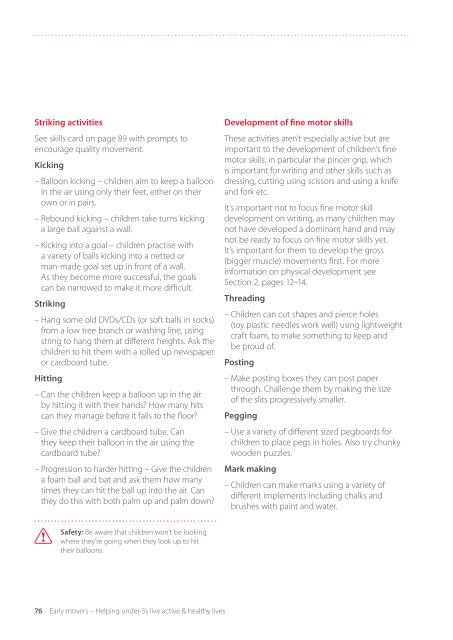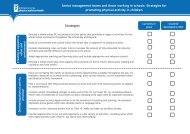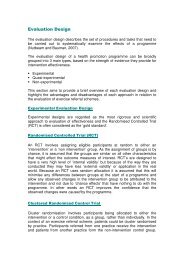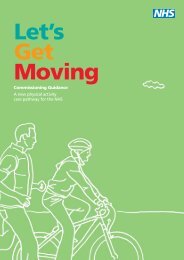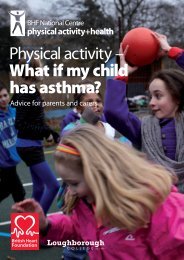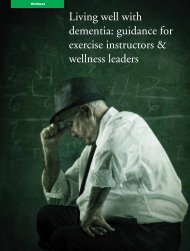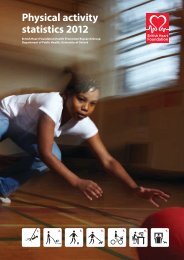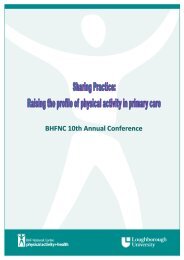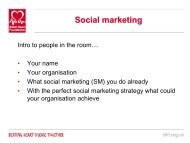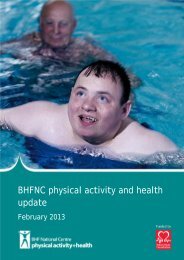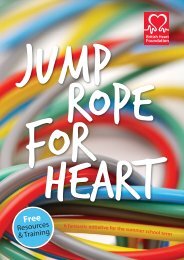5 Practical ideas for physically active play - BHF National Centre ...
5 Practical ideas for physically active play - BHF National Centre ...
5 Practical ideas for physically active play - BHF National Centre ...
- No tags were found...
Create successful ePaper yourself
Turn your PDF publications into a flip-book with our unique Google optimized e-Paper software.
Striking activitiesSee skills card on page 89 with prompts toencourage quality movement.Kicking– Balloon kicking – children aim to keep a balloonin the air using only their feet, either on theirown or in pairs.– Rebound kicking – children take turns kickinga large ball against a wall.– Kicking into a goal – children practise witha variety of balls kicking into a netted orman-made goal set up in front of a wall.As they become more successful, the goalscan be narrowed to make it more difficult.Striking– Hang some old DVDs/CDs (or soft balls in socks)from a low tree branch or washing line, usingstring to hang them at different heights. Ask thechildren to hit them with a rolled up newspaperor cardboard tube.Hitting– Can the children keep a balloon up in the airby hitting it with their hands? How many hitscan they manage be<strong>for</strong>e it falls to the floor?– Give the children a cardboard tube. Canthey keep their balloon in the air using thecardboard tube?– Progression to harder hitting – Give the childrena foam ball and bat and ask them how manytimes they can hit the ball up into the air. Canthey do this with both palm up and palm down?Development of fine motor skillsThese activities aren’t especially <strong>active</strong> but areimportant to the development of children’s finemotor skills, in particular the pincer grip, whichis important <strong>for</strong> writing and other skills such asdressing, cutting using scissors and using a knifeand <strong>for</strong>k etc.It’s important not to focus fine motor skilldevelopment on writing, as many children maynot have developed a dominant hand and maynot be ready to focus on fine motor skills yet.It’s important <strong>for</strong> them to develop the gross(bigger muscle) movements first. For morein<strong>for</strong>mation on physical development seeSection 2, pages 12–14.Threading– Children can cut shapes and pierce holes(toy plastic needles work well) using lightweightcraft foam, to make something to keep andbe proud of.Posting– Make posting boxes they can post paperthrough. Challenge them by making the sizeof the slits progressively smaller.Pegging– Use a variety of different sized pegboards <strong>for</strong>children to place pegs in holes. Also try chunkywooden puzzles.Mark making– Children can make marks using a variety ofdifferent implements including chalks andbrushes with paint and water.Cutting– Offer children the chance to pick from a rangeof scissors: ordinary, pinking shears, wavy/patterned blades and lots of different paper,card and materials to cut up.Glue sticks– Children can stick a variety of different materialsto create collages.Tearing– Children can tear up different types of paper, eg,tissue, coloured, newspaper, tin foil.Moulding– Children can mould <strong>play</strong>dough with their handsor plastic tools. Safety: Be aware that children won’t be lookingwhere they’re going when they look up to hittheir balloons.76 Early movers – Helping under-5s live <strong>active</strong> & healthy livesSection 5 – <strong>Practical</strong> <strong>ideas</strong> <strong>for</strong> <strong>physically</strong> <strong>active</strong> <strong>play</strong> 77


